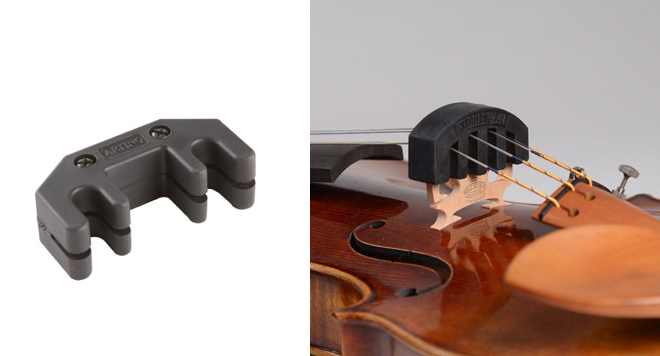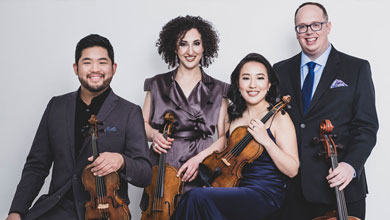Program
William Walton
String Quartet No. 2 in A minor
Antonin Dvorak
String Quartet No. 14 in A-flat Major
Verona String Quartet
Acclaimed as an “outstanding ensemble…cohesive yet full of temperament” (The New York Times), the Verona Quartet has distinguished itself by earning Chamber Music America’s coveted 2020 Cleveland Quartet Award. The Quartet serves on the faculty of Oberlin College and Conservatory as the Quartet-in-Residence.
Program Notes
William Walton (1902-1983)
String Quartet No. 2 in A minor (1947).
Performance time: 25’
In 1947, Jackson Pollack developed his new method of flinging and dripping paint onto canvas; the first transistor was successfully demonstrated at Bell Labs; UK Parliament’s Indian Independence Act created India and Pakistan; Al Capone died of syphilis in Florida.

William Walton (1902-1983)
Despite his childhood as a chorister at Christ Church, Oxford and his admission to that university at age sixteen, William Walton’s career eludes that of the proper Englishman—and of the Late Romantic English school of composition. Walton concentrated on music at Oxford, where he met Sacheverell Sitwell, brother of literary figures Edith and Osbert Sitwell. Walton was “sent down” from Oxford without a degree or any firm plans but then the Sitwells invited him to lodge in London with them. Walton took up residence in the attic of their house in Chelsea, later recalling, "I went for a few weeks and stayed about fifteen years." This association saved his composing career, encouraged his natural musical sophistication, and resulted in such adventurous works as his famous collaboration with Edith Sitwell on Façade. Walton spent World War II writing film scores—he had originally wanted to serve as an ambulance driver, but after he landed several ambulances in the ditch, the government decided that he would be more useful as a composer. In the summer of 1945, Walton set to work on today’s string quartet. He had written no major works since 1939, and Walton–a careful craftsman–required nearly two years to complete the quartet. Walton became one of the major figures in twentieth century English music alongside the tough competition of Ralph Vaughan Williams and Benjamin Britten. Here is an interesting short documentary featuring Walton and a hilarious performance by Hermione Gingold.of Façade.
All of Walton’s considerable virtues are evident in today’s string quartet: a clear sense of form, incredible rhythmic energy and virtuoso instrumental writing. The quartet is remarkable for the spotlight it shines on the usually neglected viola. Much of the characteristic sonority of this quartet comes from the viola’s mid-range sound, which announces a number of the quartet’s main ideas. The opening Allegro (fast) begins with the two middle voices (second violin and viola) from which the viola spins out the long and haunting theme that dominates this movement. The development is built around a new theme introduced by the viola and is derived from its opening statement. In its closing moments, this movement seems to lose its energy and glides to silence on the lonely sound of the second violin’s sustained tone.
The second movement (Presto—quick) goes like a streak. This is virtuoso music, full of leaps and trills; its pace broadens slightly at the ringing climax, and suddenly it has vanished. Walton mutes* his instruments for the third movement (Lento—slow) In a more introspective and emotional mood, the viola once again first lays out the long opening idea, and then the central theme. This is an extended movement, and the music plays to a great climax, performed without mutes, before falling away to a quiet close. The concluding movement (Allegro molto—very fast) returns to the energetic manner of the second movement, but there is a hard-edged brilliance about this finale: long passages are written in unison, and the blistering pace of non-stop sixteenth-notes gives this music the feel of a perpetual motion, with the melodic line whipping around between the four instruments. The opening material quickly returns, and the quartet flies to its exciting close on unison hammered A’s.
*String mutes—watch for the musicians installing them on the bridge of their instruments before starting the movement, and then later removing them, and hear the tonal difference with and without mutes.

String Mutes
Long-time Chicago Chamber Music Society patron, avid cellist and chamber musician Marshall Sparberg, MD kindly investigated the question about which YouTube performance of this work to include in these notes.* After reviewing four performances, he recommended this one by the Hollywood String Quartet (HSQ) The composer is supposed to have been so pleased with this recording that he expressed the hope that no one else would record the work! This most distinguished ensemble was founded by violinist/conductor Felix Slatkin and his wife, cellist Eleanor Aller (the parents of renouned conductor Leonard Slatkin). The HSQ is considered to be the first American-born and trained classical music chamber group to make an international impact, mainly through its landmark recordings. The musicians of the HSQ were all the progeny of Russian immigrants and all were formally trained at either the Juilliard School or the Curtis Institute of Music. They were the leading players in the major movie studio orchestras producing the vibrant, lush film soundtracks during the "Golden Age of Hollywood.”
Antonín Dvořák (1841-1904)
String Quartet no. 14 in A-Flat Major, Op. 105, B. 193* (1895).
Performance time: 32’
*Scholars list Dvořák's works by B numbers assigned by his cataloguer Burghauser, These “B” numbers are akin to “K” for Mozart’s cataloguer Köchel or “L” for Scarlatti’s cataloguer Longo.
In 1895, Paris gallery “Maison de l’Art Nouveau” opened, lending its name to the art movement; Stephen Crane published The Red Badge of Courage; CSO founder Theodore Thomas recruited Frederick Stock to the viola section, who would go on to become the CSO’s longest tenured Music Director.

Antonín Dvořák (1841-1904)
Son of a poor but musical butcher and innkeeper, Dvořàk escaped that destiny and went instead to Prague where he began composing immediately after completing his studies. He was subsequently befriended by Brahms who recognized his rare genius and championed him throughout his life. Dvořàk traveled to England and then to America, a three-year sojourn which had enormous impact on his music. He returned to his native Bohemia in 1895, the year our quartet was written, where he remained the rest of his life. At his death, he was honored with a national funeral and was buried with other national heroes.
The few solemn, foreboding measures that open today’s quartet were written while he was finishing his American stay, and may be heard as reflecting his homesickness. Then, writing when he had returned to Bohemia, the mood changes and we hear it becoming optimistic and cheerful. The second movement, one of his finest scherzos, is closely related to a Bohemian folkdance called a Furiant, suffused with its characteristic verve and irrepressible rhythmic energy. Once again, we can hear programmatic interpretations in the passionate and sorrowful song of the third movement. The mood of the final Allegro non tanto (fast but not too much) movement is one of warmth and geniality rather than of sparkling gaiety, of inner smiles rather than of joyful laughter. At the end, though, Dvořàk’s exuberance breaks through for an all-out happy conclusion, a fitting conclusion for Dvořàk’s final chamber music work.
Here is an outstanding performance of this work by The Cleveland Quartet, another outstanding American string quartet.
—Program Notes by Louise K. Smith
With thanks to Eric Bromberger, Melvin Berger, Lucy Miller Murray and most especially to Marshall Sparberg, MD.
*We cordially invite anyone interested in helping to select YouTube performances to include in our notes next year to contact me directly at louise_smith@mac.com. It is a wonderful way to get really involved with the music—please do consider it!

Verona String Quartet
Subscribe
Today!
Individual tickets may be purchased at the door (cash or check only) immediately before each concert.
All concerts are held at a private club just off Michigan Avenue in Chicago.
Call or email for more information
815-314-0681
office@ChicagoChamberMusicSociety.org